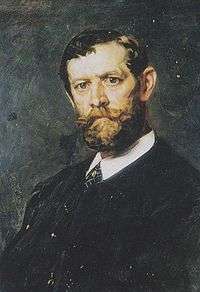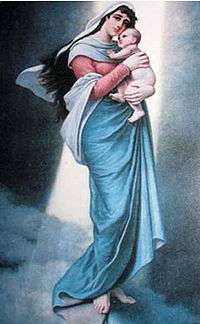Alfred Isidore Romer

Portrait by Stanisław Rostworowski (1858-1888)

Alfred Isidore Romer, or Alfred Izydor Römer (Belarusian: Альфрэд Ізідор Ромер; 16 May 1832, Vilnius - 24 January 1897, Karalinava, Pastavy Raion) was a Baltic-German/Polish painter, sculptor, printmaker and medallist who worked in what is now Lithuania and Belarus.
Biography
He was descended from a noble family that had settled in Courland in the 16th-Century. His father was Edward Jan Römer, a painter, writer and social activist. His grandfather was Michał Józef Römer, a politician who favored the abolition of serfdom.[1] His brother, Edward Mateusz Römer was also a well-known painter.
He studied drawing with Kanuty Rusiecki and continued his studies in Paris with Antoni Oleszczyński. In the late 1850s, he returned home and settled on an estate in Utena County. He also contributed prints and drawings of rural life to a magazine called Каласы (Ears of Wheat).[1]
From 1863 to 1864, he was a participant in the "January Uprising". When it failed, he was arrested and imprisoned at Dinaburg Fortress.[2] After his release, he sold his estate and moved to Germany, where he enrolled at the Academy of Fine Arts, Munich, continuing his studies with Ludwig von Hagn and Arthur von Ramberg. He also made a study trip to Italy with fellow student Albert von Keller, painting portraits of local aristocrats and copying Veronese.[2] This was followed by a series of exhibitions in Munich, Paris and Kraków.
Marriage and ethnography
In 1870, he returned to Vilnius.[1] Four years later, he moved to an estate near Karalinava that was owned by his new wife, Countess Wanda Sulistrovska (1850-1944).[1] These were among his most productive years, as he not only painted, but engaged in ethnographic studies. He wrote a monograph on the history and manufacture of a garment known as the "Slutsk Sash" and a history of the "Vilnius Academy of Fine Arts". He also made a collection of old documents that he took to the National Museum, Kraków in 1884, and lived there for several years while serving on the Art Commission of the Polish Academy of Learning.[2] In addition to his portraits and drawings, he created religious works at several churches; most notably the "Madonna of Pinsk". He returned to his wife's estate in 1894 and died there in 1897. In her later years, she became a spiritual advisor and ascetic. Plans are underway to restore the estate, which has fallen into disrepair, and create a monument.[3]
References
- 1 2 3 4 Спружына экспрэсіі Альфрэда Ромера by Boris Krepak @ Культура
- 1 2 3 Brief biography @ the Peresvetov Gallery website.
- ↑ "В Поставах намереваются установить бюст художника Альфреду Ромеру" (Plans to Install a Bust of Romer in Pastavy) @ Naviny Kultura.
Further reading
- A. Vysotsky, "Introduction to Alfred Romer" in Нарачаснская зара, №115-117., 13 September 2003
- I. Dravnitsky, "Мастакі з дынастыі Ромераў, Жыццё і творчасць, родзічы і сябры" (Artists of the Romer Dynasty: Life, Work, Family and Friends), Паставы 2013. — 60 с.
External links
| Wikimedia Commons has media related to Alfred Isidore Romer. |
- Biography and appreciation of Romer and his family @ "My Pastavy" (scroll down)
- Photographs and description of the Romer Estate @ Radzima.